Assessments/de: Difference between revisions
From LimeSurvey Manual
(Updating to match new version of source page) |
(Updating to match new version of source page) |
||
| (2 intermediate revisions by the same user not shown) | |||
| Line 7: | Line 7: | ||
<div class="mw-translate-fuzzy"> | |||
LimeSurvey bietet die Möglichkeit Antworten der Benutzer zu bewerten und diese Bewertung nach der Umfrage anzuzeigen. Diese Bewertungen werden stets nach dem Absenden der Antworten angezeigt. | |||
</div> | |||
In order to use LimeSurvey's assessment feature, access the '''survey menu''' and click on the '''Assessments''' tab: | In order to use LimeSurvey's assessment feature, access the '''survey menu''' and click on the '''Assessments''' tab: | ||
| Line 21: | Line 23: | ||
<div class=" | <div class="mw-translate-fuzzy"> | ||
Um in der Lage sein, Bewertungen für Antwortoptionen zu sehen und zu bearbeiten, besuchen Sie die Umfrage-Einstellungen und ändern Sie die Einstellung '''Bewertungen verwenden?''' im Reiter '''Benachrichtigung & Datenverwaltung''' auf 'Ja'. Danach sehen Sie zusätzliche Felder bei der Bearbeitung von Antwortoptionen. | |||
</div> | |||
=How do assessments work= | |||
Let's construct a simple example that can help you better understand the way in which the '''assessment mode''' is supposed to work. | |||
<div class="mw-translate-fuzzy"> | |||
'''Beispiel:''' Eine Umfrage besteht aus 2 Fragen: | |||
</div> | |||
<div class="mw-translate-fuzzy"> | |||
Frage 1: "Rauchen Sie?", hat 3 Antwortmöglichkeiten: | |||
*"ja, mehr als 10 Stück pro Tag" mit einem Antwortcode von "10" | |||
*"ja, aber weniger als 10 Stück pro Tag" mit einem Antwortcode von "5" | |||
*"nein, ich bin Nichtraucher" mti einem Antwortcode von "0" | |||
Frage 2: "Betreiben Sie Sport?", hat 3 Antwortmöglichkeiten: | |||
*"ja, mindestens 3x die Woche für eine halbe Stunde" mit einem Antwortcode von "0" | |||
*"ja, dann und wann" mit einem Antwortcode von "5" | |||
*"nein, ich betreibe keinen Sport" mit einem Antwortcode von "10" | |||
</div> | |||
<div class="mw-translate-fuzzy"> | |||
Wenn man nun die Summe der Antwortcodes für einen Umfrageteilnehmer heranzieht, bekommt man einen guten Wert zu dessen vermutlichen Gesundheitszustand. Jemand der raucht und keinen Sport betreibt, bekommt die Summe "20", wenn man dessen Antwortcodes zusammenzählt. Bei jemand der regelmäßig Sport betreibt und Nichtraucher ist, ergibt die Summe der Antwortcodes "0". | |||
</div> | |||
<div class="mw-translate-fuzzy"> | |||
Ein englischer Beispielfragebogen, der die Verwendung von Bewertungsregeln demonstriert, kann hier heruntergeladen und zum Testen in LimeSurvey importiert werden (Tab "importieren" beim Anlegen eines neuen Fragebogens): [[File:Limesurvey_sample_survey_Assessment.lss]] | |||
</div> | |||
= | <div class="mw-translate-fuzzy"> | ||
=Funktionsweise= | |||
</div> | |||
| Line 50: | Line 71: | ||
To start creating new assessments rules complete the fields located below the '''Assessment rules''' table. The following options are available: | To start creating new assessments rules complete the fields located below the '''Assessment rules''' table. The following options are available: | ||
*''' | <div class="mw-translate-fuzzy"> | ||
*''' | Im Neu anlegen oder Bearbeiten-Fenster stehen folgende Aktionen zur Auswahl: | ||
*'''Bereich:''' legt den Bereich fest, auf dessen Basis die Bewertung vollzogen werden soll. Verwenden Sie "Gesamt", um eine Bewertung anhand der Summe der Antwortcodes aller Fragen der Umfrage zu erstellen. Bei "Gruppe" müssen sie nachfolgend die entsprechende Gruppe wählen, auf welche sich die Bewertung beziehen soll. | |||
*'''Gruppe:''' Falls sie im Bereich "Gruppe" gewählt haben, müssen sie die entsprechende Gruppe auswählen, auf deren Basis die Bewertung gemacht werden soll. | |||
*'''Minimum:''' Der Minimalwert der Summe aus den Antwortcodes, für welche die Bewertung gilt. | |||
*'''Maximum:''' Der Maximalwert der Summe aus den Antwortcodes, für welche die Bewertung gilt. | |||
*'''Überschrift:''' Die Überschrift der Bewertung, welche angezeigt wird, wenn die Bewertung ausgegeben wird. | |||
*'''Meldung:''' Die Meldung, welche angezeigt wird, wenn die Bedingung für die Bewertung erfüllt wird. Diese Meldung kann HTML-Code enthalten. Außerdem können die untenstehenden Platzhalter verwendet werden. | |||
</div> | |||
| Line 71: | Line 99: | ||
<div class=" | <div class="mw-translate-fuzzy"> | ||
Wichtig ist, wenn sie eine Bewertungen ausgeben möchten, müssen sie ihre Umfrage so anlegen, dass nach dem Absenden der Ergebnisse nicht automatisch eine End-URL geladen wird. Diese Einstellung wird im allgemeinen Einstellungsmenü der Umfrage festgelegt. Denn die Bewertung wird auf der Abschluss-Seite einer Umfrage ausgegeben, welche in dieses Fall sonst übersprungen werden würde. | |||
</div> | |||
| Line 77: | Line 107: | ||
<div class="mw-translate-fuzzy"> | |||
Es gibt bestimmte [[Fragetypen]], die nicht bewertet oder auf besondere Weise bewertet werden. Die meisten Fragetypen, die nicht bewertet werden können, sind Convenience-Frage-Typen. Diese können meist durch bewertbare Fragetypen ersetzt werden - zum Beispiel eine 5-Punkte-Auswahl-Frage kann jederzeit durch eine Einfachauswahl-Frage ersetzt werden. | |||
</div> | |||
<div class="mw-translate-fuzzy"> | |||
===Fragetypen mit Bewertungsregeln=== | |||
*Array (Flexible labels) dual scale | *Array (Flexible labels) dual scale | ||
*Array (Flexible labels) | *Array (Flexible labels) | ||
| Line 88: | Line 121: | ||
*List (Radio) | *List (Radio) | ||
*List with comment | *List with comment | ||
* Multiple options | *Multiple options | ||
* Multiple options with comments | *Multiple options with comments | ||
</div> | |||
<hr width="50%" style="margin:auto"> | <hr width="50%" style="margin:auto"> | ||
<div class="mw-translate-fuzzy"> | |||
===Nicht unterstützte Fragetypen=== | |||
* 5 point choice | * 5 point choice | ||
* Array (5 point choice) | * Array (5 point choice) | ||
| Line 101: | Line 136: | ||
* Array (Multi flexible) (Text) | * Array (Multi flexible) (Text) | ||
* Array (Yes/No/Uncertain) | * Array (Yes/No/Uncertain) | ||
* | * Boilerplate question | ||
* Date | * Date | ||
* Gender | * Gender | ||
| Line 113: | Line 147: | ||
* Short free text | * Short free text | ||
* Yes/No | * Yes/No | ||
</div> | |||
| Line 140: | Line 175: | ||
<div class="mw-translate-fuzzy"> | |||
* | Bei der Nutzung von Bewertungsregeln können die folgenden Platzhalter verwendet werden | ||
* | * {PERC}: Zeigt den Punktewert für eine Gruppe an. Kann nur innerhalb der abschließenden Meldung genutzt werden. | ||
* '''{ASSESSMENT_CURRENT_TOTAL} | * {TOTAL}: Zeigt den Gesamtpunktewert an. Kann nur innerhalb der abschließenden Meldung genutzt werden. | ||
* ''seit 1.86'': {ASSESSMENT_CURRENT_TOTAL}: Dieser Platzhalter kann innerhalb eines Fragebogens genutzt werden, um den aktuellen Gesamtpunktestand anzuzeigen, beispielsweise innerhalb eines Hinweistextes einer Frage. Um den Platzhalter nutzen zu können, muss eine Bewertungsregel für den gesamten Fragebogen angelegt sein. Der Wert wird aktualisiert, wenn der Benutzer im Fragebogen auf "weiter" geklickt hat, in einem Fragebogen mit nur einer Seite ist er also nutzlos. | |||
</div> | |||
If your survey is '''not''' anonymous, the following placeholders are available. | If your survey is '''not''' anonymous, the following placeholders are available. | ||
* '''{EMAIL}''': It displays the email of the respondent from the survey participants table | * '''{TOKEN:EMAIL}''': It displays the email of the respondent from the survey participants table | ||
* '''{FIRSTNAME}''': It displays the first name of the respondent from the survey participants table | * '''{TOKEN:FIRSTNAME}''': It displays the first name of the respondent from the survey participants table | ||
* '''{LASTNAME}''': It displays the last name of the respondent from the survey participants table | * '''{TOKEN:LASTNAME}''': It displays the last name of the respondent from the survey participants table | ||
* '''{TOKEN}''': It displays the token code of the respondent from the survey participants table | * '''{TOKEN}''': It displays the token code of the respondent from the survey participants table | ||
= | <div class="mw-translate-fuzzy"> | ||
=Tipps & Tricks= | |||
* Wenn Sie '''nur den {ASSESSMENT_CURRENT_TOTAL} Platzhalter''' innerhalb einer Umfrage benutzen wollen, ohne dass eine Bewertungsnachricht am Ende der Umfrage gezeigt wird, konfigurieren Sie eine [[Creating_a_new_survey/de|End-URL]] und aktivieren Sie das automatische Laden der End-URL für Ihre Umfrage. Anschließend wird der Nutzer direkt an die angegebene URL weitergeleitet. | |||
</div> | |||
| Line 159: | Line 199: | ||
=How to disable the | =How to disable the assessment mode= | ||
| Line 171: | Line 211: | ||
==How to use the | ==How to use the assessment mode== | ||
Let's recreate the [[Assessments#How do assessments work|example presented above]] in order to better understand the steps you have to pursue in order to correctly use the assessment feature. | Let's recreate the [[Assessments#How do assessments work|example presented above]] in order to better understand the steps you have to pursue in order to correctly use the assessment feature. | ||
Revision as of 18:30, 1 November 2018
Einleitung
LimeSurvey bietet die Möglichkeit Antworten der Benutzer zu bewerten und diese Bewertung nach der Umfrage anzuzeigen. Diese Bewertungen werden stets nach dem Absenden der Antworten angezeigt.
In order to use LimeSurvey's assessment feature, access the survey menu and click on the Assessments tab:
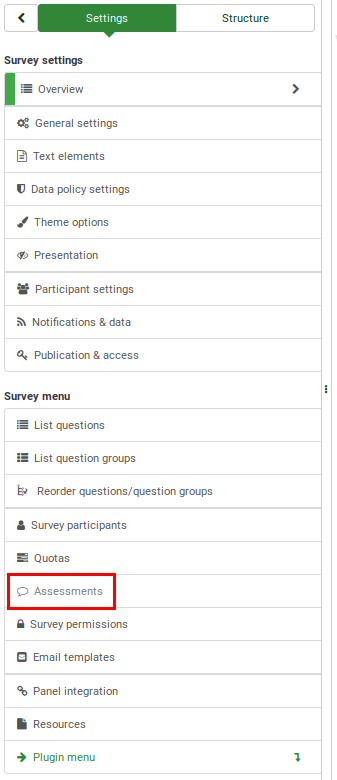
Once there, enable the assessment mode:

Um in der Lage sein, Bewertungen für Antwortoptionen zu sehen und zu bearbeiten, besuchen Sie die Umfrage-Einstellungen und ändern Sie die Einstellung Bewertungen verwenden? im Reiter Benachrichtigung & Datenverwaltung auf 'Ja'. Danach sehen Sie zusätzliche Felder bei der Bearbeitung von Antwortoptionen.
How do assessments work
Let's construct a simple example that can help you better understand the way in which the assessment mode is supposed to work.
Beispiel: Eine Umfrage besteht aus 2 Fragen:
Frage 1: "Rauchen Sie?", hat 3 Antwortmöglichkeiten:
- "ja, mehr als 10 Stück pro Tag" mit einem Antwortcode von "10"
- "ja, aber weniger als 10 Stück pro Tag" mit einem Antwortcode von "5"
- "nein, ich bin Nichtraucher" mti einem Antwortcode von "0"
Frage 2: "Betreiben Sie Sport?", hat 3 Antwortmöglichkeiten:
- "ja, mindestens 3x die Woche für eine halbe Stunde" mit einem Antwortcode von "0"
- "ja, dann und wann" mit einem Antwortcode von "5"
- "nein, ich betreibe keinen Sport" mit einem Antwortcode von "10"
Wenn man nun die Summe der Antwortcodes für einen Umfrageteilnehmer heranzieht, bekommt man einen guten Wert zu dessen vermutlichen Gesundheitszustand. Jemand der raucht und keinen Sport betreibt, bekommt die Summe "20", wenn man dessen Antwortcodes zusammenzählt. Bei jemand der regelmäßig Sport betreibt und Nichtraucher ist, ergibt die Summe der Antwortcodes "0".
Ein englischer Beispielfragebogen, der die Verwendung von Bewertungsregeln demonstriert, kann hier heruntergeladen und zum Testen in LimeSurvey importiert werden (Tab "importieren" beim Anlegen eines neuen Fragebogens): File:Limesurvey sample survey Assessment.lss
Funktionsweise
Once enabled, the following page will load up:
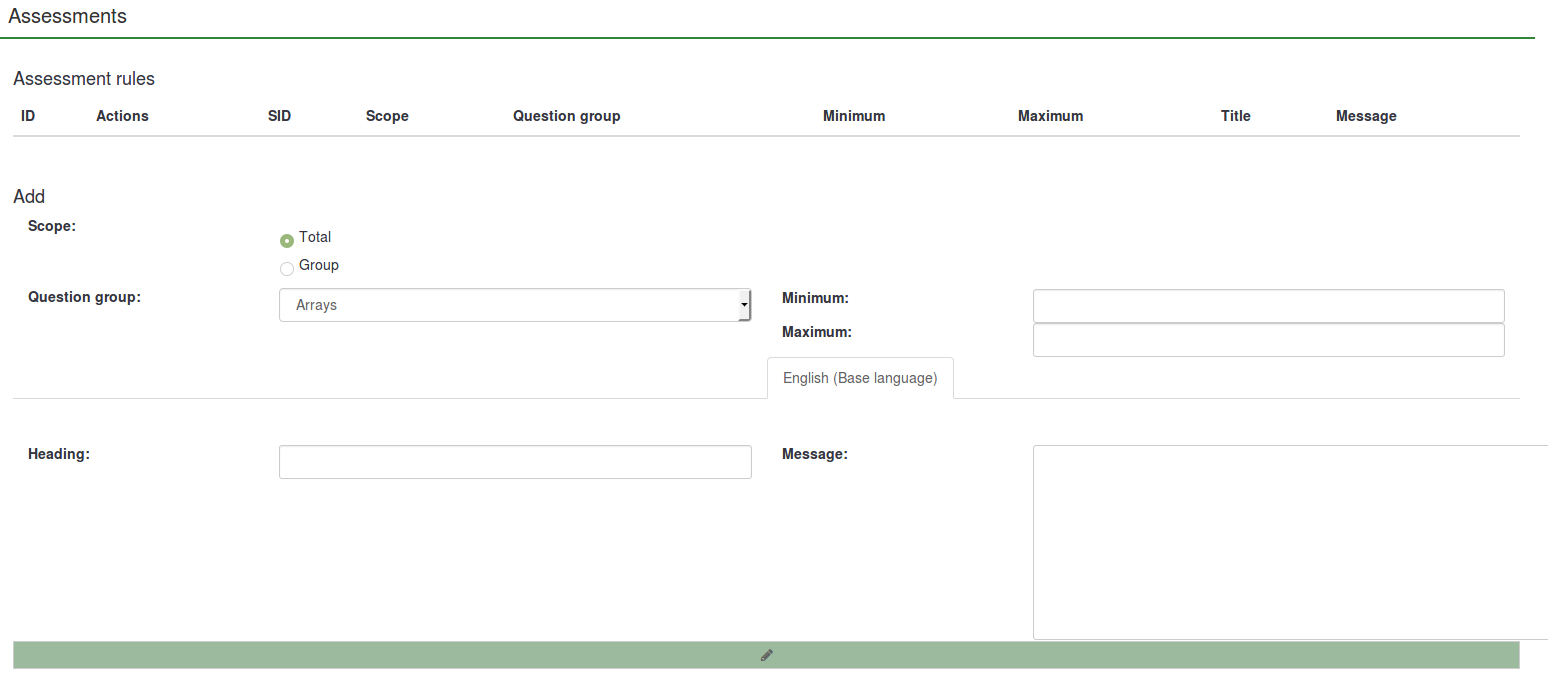
To start creating new assessments rules complete the fields located below the Assessment rules table. The following options are available:
Im Neu anlegen oder Bearbeiten-Fenster stehen folgende Aktionen zur Auswahl:
- Bereich: legt den Bereich fest, auf dessen Basis die Bewertung vollzogen werden soll. Verwenden Sie "Gesamt", um eine Bewertung anhand der Summe der Antwortcodes aller Fragen der Umfrage zu erstellen. Bei "Gruppe" müssen sie nachfolgend die entsprechende Gruppe wählen, auf welche sich die Bewertung beziehen soll.
- Gruppe: Falls sie im Bereich "Gruppe" gewählt haben, müssen sie die entsprechende Gruppe auswählen, auf deren Basis die Bewertung gemacht werden soll.
- Minimum: Der Minimalwert der Summe aus den Antwortcodes, für welche die Bewertung gilt.
- Maximum: Der Maximalwert der Summe aus den Antwortcodes, für welche die Bewertung gilt.
- Überschrift: Die Überschrift der Bewertung, welche angezeigt wird, wenn die Bewertung ausgegeben wird.
- Meldung: Die Meldung, welche angezeigt wird, wenn die Bedingung für die Bewertung erfüllt wird. Diese Meldung kann HTML-Code enthalten. Außerdem können die untenstehenden Platzhalter verwendet werden.
- Minimum: The minimum score to which this assessment will apply.
- Maximum: The maximum score of answers to which this assessment will apply;
- Heading: The heading of the assessment which will be displayed if the assessment is going to be displayed;
- Message: It represents the text message of the assessment - what is displayed at the end of the survey to the respondents. You can use the placeholders such as {PERC} and/or {TOTAL} to emphasize the scores of each survey question group or the total survey score. Click on the green pencil button to access the HTML-editor and enhance the final message of the assessment by adding colours, tables, images, and so on.
Sie können so viele Bewertungen anlegen wie sie möchten. Sie können zu einer bestimmten Punkteanzahl auch mehrere Bewertungen ausgeben lassen.
After adding some assessments, the possible assessments actions will be displayed under the Actions column in the Assessments rules table. From there, you can either edit or delete an assessment rule:
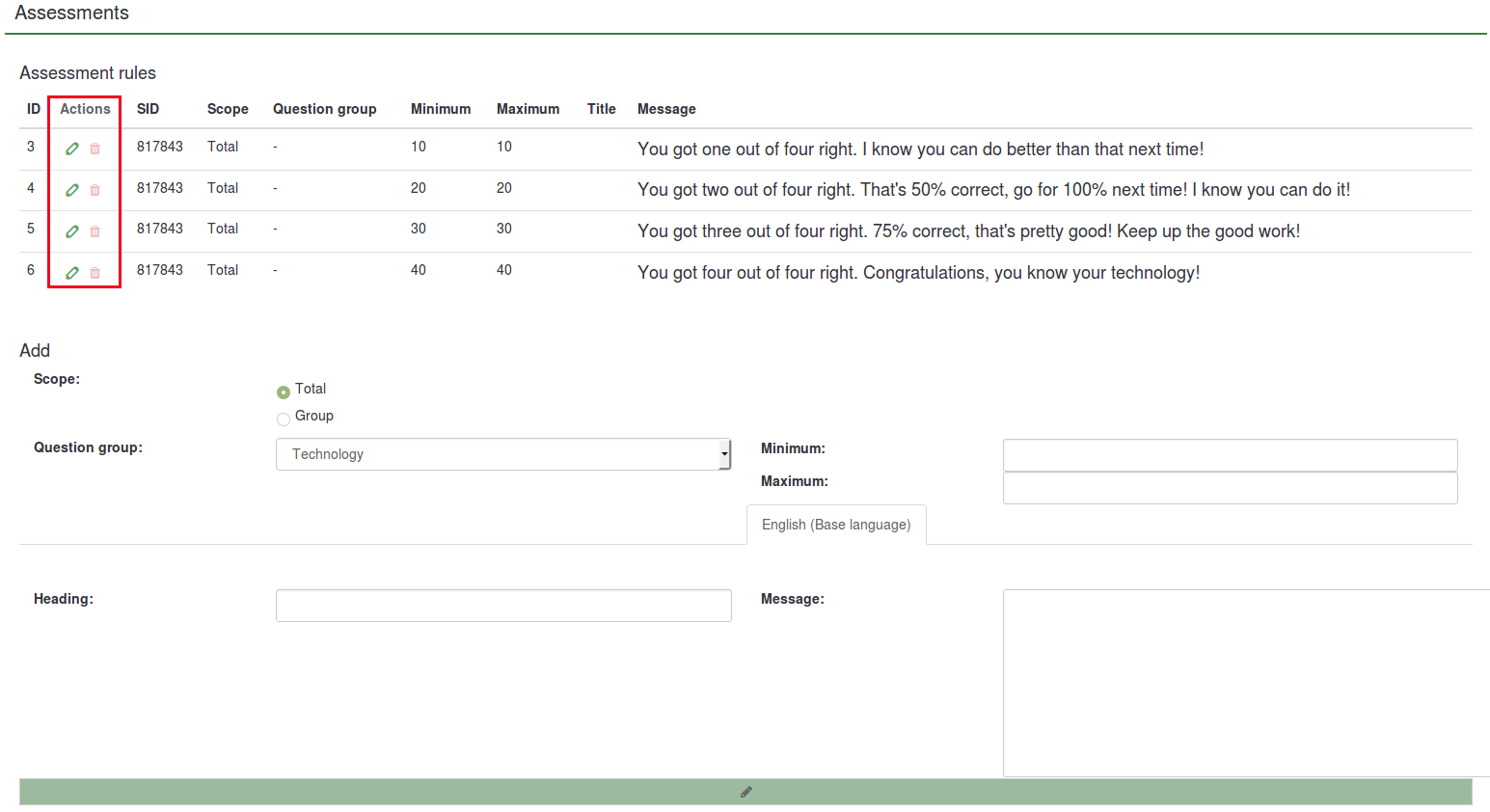
Wichtig ist, wenn sie eine Bewertungen ausgeben möchten, müssen sie ihre Umfrage so anlegen, dass nach dem Absenden der Ergebnisse nicht automatisch eine End-URL geladen wird. Diese Einstellung wird im allgemeinen Einstellungsmenü der Umfrage festgelegt. Denn die Bewertung wird auf der Abschluss-Seite einer Umfrage ausgegeben, welche in dieses Fall sonst übersprungen werden würde.
Auswertung der Punktzuweisungen
Es gibt bestimmte Fragetypen, die nicht bewertet oder auf besondere Weise bewertet werden. Die meisten Fragetypen, die nicht bewertet werden können, sind Convenience-Frage-Typen. Diese können meist durch bewertbare Fragetypen ersetzt werden - zum Beispiel eine 5-Punkte-Auswahl-Frage kann jederzeit durch eine Einfachauswahl-Frage ersetzt werden.
Fragetypen mit Bewertungsregeln
- Array (Flexible labels) dual scale
- Array (Flexible labels)
- Array (Flexible labels) by column
- List (Flexible labels) (Dropdown)
- List (Flexible labels) (Radio)
- List (Dropdown)
- List (Radio)
- List with comment
- Multiple options
- Multiple options with comments
Nicht unterstützte Fragetypen
- 5 point choice
- Array (5 point choice)
- Array (10 point choice)
- Array (Increase, Same, Decrease)
- Array (Multi flexible) (Text)
- Array (Yes/No/Uncertain)
- Boilerplate question
- Date
- Gender
- Huge free text
- Language switch
- Long free text
- Multiple numerical input
- Numerical input
- Ranking
- Short free text
- Yes/No
Bewertungen zuweisen
If enabled, the assessment mode will add an additional field between the answer code and answer option name for all the assessable questions:

You can also use label sets as answers for your set of questions. Just click on the Predefined label sets... button located under the answers matrix and select your predefined label set.
If you decide to use label sets, assessment values can be added to all your labels from the moment in which they are first created. This allows the survey administrator to quickly use few assessed predefined label sets as answers for multiple sets of questions.

This process is less time-consuming and more practical. You can create a plan in the early stages of your survey in order to use only one set of label sets with predefined assessment values for multiple questions. In this way, you will not have to manually add assessment values to all the answers of the assessable questions used in your survey.
Platzhalter
Bei der Nutzung von Bewertungsregeln können die folgenden Platzhalter verwendet werden
- {PERC}: Zeigt den Punktewert für eine Gruppe an. Kann nur innerhalb der abschließenden Meldung genutzt werden.
- {TOTAL}: Zeigt den Gesamtpunktewert an. Kann nur innerhalb der abschließenden Meldung genutzt werden.
- seit 1.86: {ASSESSMENT_CURRENT_TOTAL}: Dieser Platzhalter kann innerhalb eines Fragebogens genutzt werden, um den aktuellen Gesamtpunktestand anzuzeigen, beispielsweise innerhalb eines Hinweistextes einer Frage. Um den Platzhalter nutzen zu können, muss eine Bewertungsregel für den gesamten Fragebogen angelegt sein. Der Wert wird aktualisiert, wenn der Benutzer im Fragebogen auf "weiter" geklickt hat, in einem Fragebogen mit nur einer Seite ist er also nutzlos.
If your survey is not anonymous, the following placeholders are available.
- {TOKEN:EMAIL}: It displays the email of the respondent from the survey participants table
- {TOKEN:FIRSTNAME}: It displays the first name of the respondent from the survey participants table
- {TOKEN:LASTNAME}: It displays the last name of the respondent from the survey participants table
- {TOKEN}: It displays the token code of the respondent from the survey participants table
Tipps & Tricks
- Wenn Sie nur den {ASSESSMENT_CURRENT_TOTAL} Platzhalter innerhalb einer Umfrage benutzen wollen, ohne dass eine Bewertungsnachricht am Ende der Umfrage gezeigt wird, konfigurieren Sie eine End-URL und aktivieren Sie das automatische Laden der End-URL für Ihre Umfrage. Anschließend wird der Nutzer direkt an die angegebene URL weitergeleitet.
- If you only want to use the {ASSESSMENT_CURRENT_TOTAL} placeholder within a survey without showing an assessment message at the end of the survey:
- Access the Survey text elements panel and type in a URL field and
- Enable the autoload URL located in the Presentation panel.
How to disable the assessment mode
To deactivate it, go to the survey menu and look for the Data management tab. Click on it and the Notification and data management panel will be displayed. Look for the Enable assessment mode option and click on it to have it disabled for the respective survey.

Examples
How to use the assessment mode
Let's recreate the example presented above in order to better understand the steps you have to pursue in order to correctly use the assessment feature.
2) Activate the assessments. Go to the settings menu of the survey and click on the Assessments tab. Once there, activate the feature:

3) Create a question group and start adding the questions. Your survey structure should look like this:
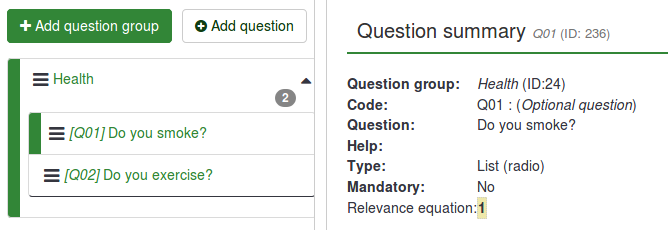
4) Add answers for each question created above. While adding/editing the answers, complete also the assessment value field for each answer:

5) Now that you know the assessment values, access the Assessments panel and start adding assessment rules. Two rules were created for this example:

The text message of the first assessment rule (You should start exercising!) will be displayed if the respondent scores between 1 and 10 points. The text message of the second assessment rule (Well, that's what I call being healthy!) will be shown if the respondent scores between 11 and 21 points.
6) Now, preview the survey and see if the assessment mode is active. At the end of the survey, a text message will be displayed based on the score obtained by the respondent.

How to use the assessment placeholders
As mentioned in the previous subsection, three assessment-related placeholders can be used: {PERC}, {TOTAL}, and {ASSESSMENT_CURRENT_TOTAL}.
In the previous example, the following result was obtained: "Well, that's what I call being healthy!". However, no score was displayed.
There are many ways through which you can have it displayed. You can either create 6 assessment rules in order to emphasize each possible score/result or use assessment placeholders. The below example explains the latter option.
As mentioned above, {PERC} and {TOTAL} can be used in the message text box of the assessment rule in order to emphasize the score of the current group and the total score, respectively. Let's take a look at the following two screenshots to understand their usage.

In the first screenshot, {PERC} and {TOTAL} were added into the message text box of the assessment rule.

In the second screenshot, you can see how the assessment rule looks like in order to correctly use both placeholders. Because {PERC} is used, the scope of the assessment rule must be switched from Total to Group in order to correctly display the score of the question group selected from the Question group dropdown list:

After completing the survey and depending on their answers, the respondents should get the following assessment message at the end:
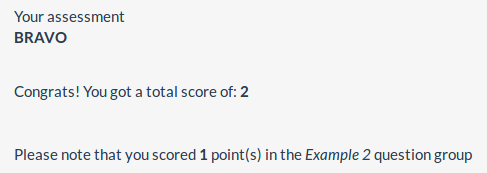
{ASSESSMENT_CURRENT_TOTAL} can be used only inside a survey. You can use it after each question or question group from a quiz. You could show in this way to each respondent his or her current quiz/survey score. To use it, you could add for example at the beginning of every question or question group a message like: "You have accumulated till now {ASSESSMENT_CURRENT_TOTAL} points".
Video tutorial
To understand the basics of the LimeSurvey assessments feature, check the following video.